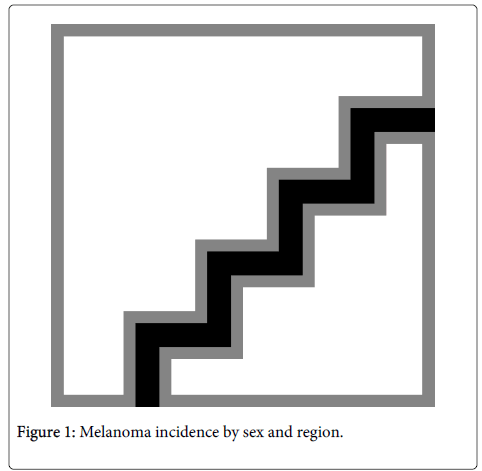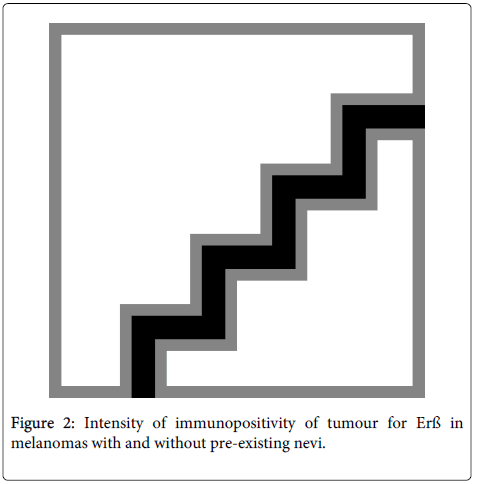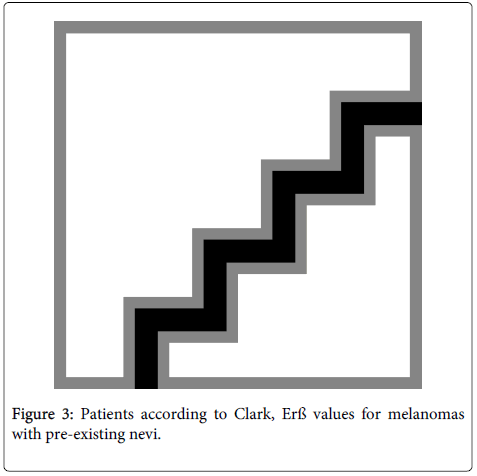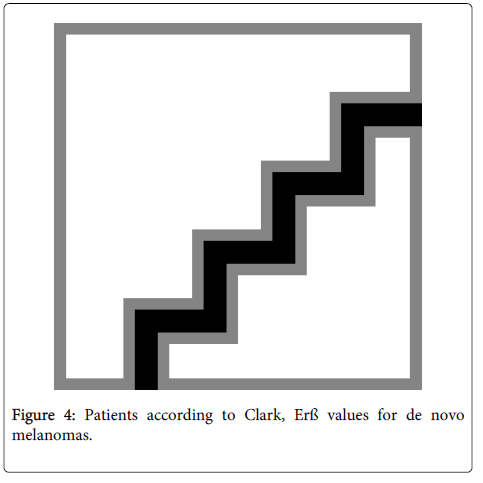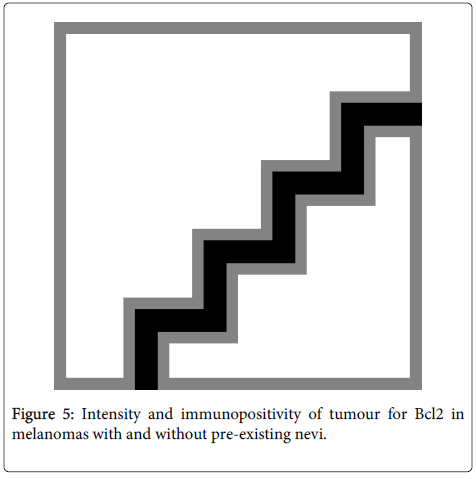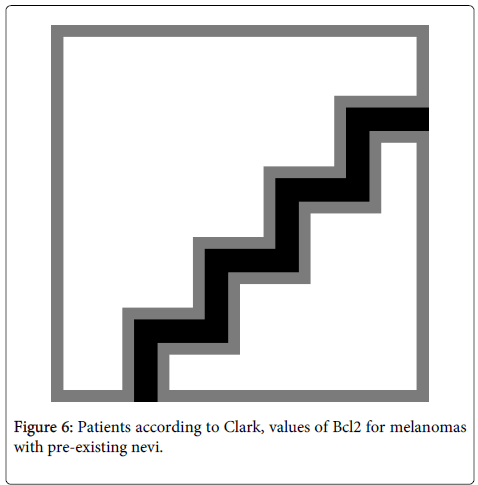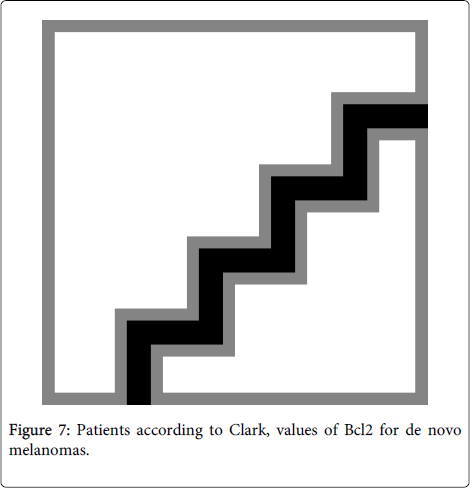Research Article Open Access
Expression of Erß and Bcl-2 in Skin Melanoma
Mufid Burgic1*, Ermina Iljazovic2, Šefik Hasukic3, Adi Rifatbegovic1, Musfaha Burgic1, Emir Halilbašic1 and Eldar Brkic1
1Department of Plastic Surgery, Clinic for Plastic and Maxillofacial Surgery, University Clinical Center Tuzla, Bosnia and Herzegovina
2Departement of Pathology, Policlinic for Laboratory Diagnostics, University Clinical Center Tuzla, Bosnia and Herzegovina
3Clinic for General Surgery, University Clinical Center Tuzla, Bosnia and Herzegovina
- *Corresponding Author:
- Mufid Burgic
Department of Plastic Surgery
Clinic for Plastic and Maxillofacial Surgery
University Clinical Center Tuzla
Bosnia and Herzegovina
Tel: 387 61 39 31 53 E-mail: burgicmufid@yahoo.com
Received Date: July 05, 2014; Accepted Date: January 27, 2015; Published Date: Febuary 03, 2015
Citation: Burgic M, Iljazovic E, Hasukic S, Rifatbegovic A, Burgic M et al. (2015) Expression of Erß and Bcl-2 in Skin Melanoma. J Clin Exp Pathol 5:207. doi: 10.4172/2161-0681.1000207
Copyright: ©2015 Burgic M, et al. This is an open-access article distributed under the terms of the Creative Commons Attribution License, which permits unrestricted use, distribution, and reproduction in any medium, provided the original author and source are credited.
Visit for more related articles at Journal of Clinical & Experimental Pathology
Abstract
Introduction: Skin melanoma has been one of the most researched malignant melanoma of today. Its "popularity" among the researchers and clinicians arises from variety of forms and biological behaviour, it's characteristic appearance, genetic and immunologic certainty and its prognostic uncertainty.
Patients and methods: We analyzed 62 patients with a primary skin melanoma diagnosed in the period from January 2001, to June 2010 (patients were divided in two groups; Group A: patients with melanoma development based on pre-existed nevi and Group B: de novo melanomas). The clinicopathological parameters determined for each tumour were histological type, Breslow thickness, Clark level, and pathological disease stage. The results were correlated with expression of estrogen receptor beta (Erß) and Bcl2.
Results: Comparing individual groups according to the intensity of positivity in relation to the stage of Clark, we recognize differences in the distribution of patients with pre-existent nevi (group A), but not in de novo melanoma (group B). Significant differences between individual groups for Erß and Bcl2 expression in terms of intensity of positivity in relation to Clark level (III/IV) showed differences in distribution in patients with pre-existing nevi (Group A). After adjusting for age and sex, we found that Erß and Bcl2 expression was significantly higher in patient with pre-existing nevi in higher melanoma tissue compared with thin melanoma tissue.
Conclusion: Expression of ER in Clark level III and IV is higher in melanoma arising from pre-existing nevi, giving better chance of survival to our patients in comparison to de novo melanoma.
Keywords
Skin melanoma; Erß; Bcl-2; Prognostic factors
Introduction
Skin melanoma has been one of the most researched malignant melanoma of today. Its "popularity" among the researchers and clinicians arises from variety of forms and biological behaviour, it's characteristic appearance, genetic and immunologic certainty and its prognostic uncertainty. Although this malignant disease is rare in terms of total human morbidity, it is classified as one of the most malignant ones due to its mortality [1,2]. Increased incidence of melanoma, regardless of its mechanism of development, induced many researchers to search for new prognostic and predictive markers in melanoma. Melanoma results from a disruption of the normal regulation of cell growth and reproduction. There are various carcinogenesis mechanisms, and a number of recent research papers deal with tumour suppression gene analysis and the role of apoptosis in melanoma development. Mutation in tumour suppression gene has been proved in melanoma and it is considered to be involved in the pathogenesis of this disease [3]. Estrogen receptors have been isolated in various concentrations and ratios in all malignant tumours. Estrogen receptors are proteins belonging to a big family of nuclear hormonal receptors [4]. The characterization of Estrogen Receptor Beta (ERß) brought new insight into the mechanisms underlying estrogen signaling. Estrogen induction of cell proliferation is a crucial step in carcinogenesis of gynaecologic target tissues, and the mitogenic effects of estrogen in these tissues (such as breast, endometrium and ovary). In all of these tissues, most studies have shown decreased ERß expression in cancer as compared with benign tumours or normal tissues, whereas Estrogen Receptor Alpha (ERα) expression persists. The loss of ERß expression in cancer cells could reflect tumour cell dedifferentiation but may also represent a critical stage in estrogendependent tumour progression. Modulation of the expression of ERα target genes by ERß or ERß-specific gene induction could explain that ERß has a differential effect on proliferation as compared with ERα. ERß may exert a protective effect and thus constitute a new target for hormone therapy, such as ligand specific activation [5]. The potential distinct roles of ERß expression in melanoma, as suggested by experimental and clinical data, are discussed in this review
Apoptosis, or programmed cell death, has become the topic of interest in pathogenesis of melanoma development. The discovery of Bcl2 gene, as the main inhibitor of apoptosis, has opened some new perspectives studies on treatment of metastatic melanoma by addition of Bcl2 "antisense" [6].
These receptors have a significant role in prognosis and manner of treatment of patients with melanoma. The aim of Erß treatment, including development of Erß-specific ligands, is to offer a new treatment approach to pre-invasive and proliferative lesions. Clinical merit of Erß and Bcl2 in prognosis of melanoma and its possible application should be evaluated as a prognostic factor hormone response of tumours, since a low level of estrogen receptors and Bcl2 implies worse prognosis and higher possibility of metastasis of the primary melanoma.
Oncological research has focused on evaluating Erß and Bcl2 in skin melanoma, and understanding the potential role of Erß and Bcl2 in the pathophysiology of cancer. However, the intensity of immunopositivity and expression of Erß and Bcl2 in skin melanoma arising from pre-existing nevi are unknown. This study has been conducted in order to establish whether melanomas arising from preexisting nevi have different expression of estrogen receptors in comparison to de novo melanomas, and what is the role of Bcl-2.
Materials and Methods
This retrospective study included 62 patients surgically treated at the University Clinical Center Tuzla, from January 2001 to June 2010, who were initially diagnosed with skin melanoma in accordance to the final results obtained by histological examination of excised lesions. All the necessary macro and micro analysis of surgically obtained samples were done at the Pathology polyclinic for laboratory diagnostics of University Clinical Center in Tuzla. The clinicopathological parameters determined for each tumour were histological type, Breslow thickness, Clark level, and pathological disease stage. The results were correlated with expression of Erß and Bcl2. The patients have been divided in two groups. Group A consisted of 31 patients with melanoma arising from pre-existing nevi, and group B of 31 patients with de novo melanoma.
A immunohistochemical staining for Bcl-2 (DAKO, monoclonal mouse anti-human Bcl-2 oncoprotein, Clone 124, 1:50 dilution) and estrogen beta (Clone PPG 5/10) were performed on all tissue samples in order to establish the distribution and intensity of expression, expressed through score for Bcl-2. All samples were subjected to immune-hystochemical colouring on Bcl-2 (DAKO, monoclonal mouse anti-human Bcl-2 oncoprotein, Clone 124, dilution 1:50), estrogen beta (5/10 Clone PPG), which is the Bcl-2 is expressed through the score. Score is obtained by multiplying the intensity of staining and the percentage of positive cells. Immunopositivity is cytoplasmic. The intensity of staining is graded as 1 (mild), 2 (moderately strong) and as 3 (strong), and the percentage of cellular expression is graded as 0 (negative), 1 (1-25%), 2 (26-50%), 3 (51-75%) and 4 (>75%). The expression of estrogen beta is manifested on the nucleus, and is defined as the percentage of positive nucleus or cells. Microscopic analysis was performed on the microscope Olympus Bx41. Preparations for immunohystochemical analysis are deparaffined and then incubated for thirty minutes in 1.5% H2O2to block endogenous peroxidase activity, and then pretreated in citrate buffer (10 mM, pH 6.0) at 100°C for 15 minutes. Slides with histological sections were assembled on appropriate beams and located in the center of colouring Seqeunza-Shandon, where all degrees of incubation were made. Pre-incubation level of 15 minutes with 10% normal bovine serum was observed by the three-step immunoperoxidase method. Incubation with primary antibody lasted for 60 minutes, then 30 minutes with a secondary antibody labelled with biotin and streptavidin and with peroxidase. Peroxidase activity was developed with 3,3-diaminobenzidine tetrachloride and H2O2 as substrate.
Contrast staining was done with hematoxylin, and after the dehydration, the product is mounted with Canadian balsam. For each tested sample, in parallel with the same method, the appropriate tissue histology sections are treated, as positive control. Reliable positive reaction was considered nuclear positivity of surface of the cell membrane. Basic methods of descriptive statistics were used in data analysis. Given hypotheses were statistically tested at the level of α=0.05, with the significance of p<0.05.
Erß and Bcl2 was detected with varying staining intensity in 62 malignant melanocytic lesions. After adjusting for age and sex, we found that Erß and Bcl2 expression was significantly higher in patients with pre-existing nevi in higher melanoma tissue compared with thin melanoma tissue. Gender distribution showed that there were 40 (64.5%) female and 22 male (35.4%) patients with primary skin melanoma, yielding in odds ratio 1.5:1 in favour of female patients. Patients were between the ages 17 and 80, an average age were 55 years for both genders. The most common sites for skin melanoma were found to be at trunk (51.4% of both genders or 25.7% of male and 25.7% of female), limbs (24.3% of both genders or 7.1% of male and 17.1% of female), and head and neck (24.3%of both genders or 11.4% of male and 12.9% of female), (Figure 1). This data shows the increasing number of female patients with skin melanoma on head, neck and limbs. The majority of patients with skin melanoma were diagnosed in stage T4. In both tested groups, the most frequent level was Clark III (35.5 %) in group A and (38.7%) in group B. The average Breslow's depth of invasion was 2.91 (ranging from 0 to 14 mm) in group A, and 4.20 mm (ranging from 0 to 15 mm) in group B. Distribution of skin melanoma according to Breslow staging system is shows that most of tumours had thickness between 2.01-4.00 mm.
Statistical analysis with regards to Erß showed no significant differences in estrogen beta expression between the groups tested (p=0.21), (Figure 2). Comparison of individual groups in terms of intensity of positivity in relation to Clark level showed differences in distribution in patients with pre-existing nevi (group A), (p=0.05), but not in de novo melanoma patients (group B), (p=0.13), (Figure 3 and 4).
Significant differences between individual groups for Erß and Bcl2 expression in terms of intensity of positivity in relation to Clark level (III/IV) showed differences in distribution in patients with preexisting nevi (group A), (p=0.05). Significantly negative correlations were observed for patients with de novo melanoma for both group B, and is inversely associated with Breslow thickness.
Statistical analysis of Bcl2 showed no significant differences in Bcl2 expression between the two groups (p=0.73), (Figure 5). Comparison of individual groups in relation to Clark level showed differences in Bcl2 expression in patients with pre-existing nevi (group A), (p=0.05), but not in de novo melanoma patients (group B), (p=0.28), (Figure 6 and 7).
Discussion
Skin melanoma is an aggressive malignant disease, of particular interest to researchers due to its specific behaviour, possibility of recurrence and diversity of metastasis [7]. Understanding of etiologic factors significant for melanoma development along with research of the same contribute to early diagnosis and higher success of treatment. Some melanomas appear de novo, meaning that they originate as malignant forms, while others arise by malignant transformation from nevi. Skin melanoma with histologically confirmed presence of nevi cells can have different risk factors than melanoma without such cells (de novo). Melanoma is caused by disruption of the normal regulation of cell growth and reproduction. Gene mechanisms responsible for initiation and progression of this tumour have not been completely clarified yet [8].
In this study, the largest number of verified melanoma in males and females , regardless of the histological type were Clark level III, with primary tumour thickness from 2.01 to 4 mm. The study by Kruslin et.al., showed that most primary tumours were diagnosed in Clark level III and IV, with primary tumour thickness ranging from 2 mm to 4 mm, and over 4 mm [9]. Distribution of primary tumours, according to Clark and Breslow, is established by our study and it correlates to available bibliography data from the neighbouring countries.
However, immune-histochemical techniques can play an important role in some cases, especially in diagnosing primary melanoma. After the first publications on existence of cytoplasmatic estrogen receptors in patients with skin melanoma, in the mid-70s, many authors proved receptor activity of steroid hormones in melanoma tissue, however this was only in individual melanoma cells and in small quantity [10]. Various studies have proved that ERß is the dominant estrogen receptor in all kinds of benign and malignant melanocytic lesions. The expression of Erß also correlates to malignant tumour microenvironment proximity of melanocytes to keratinocytes, deeper dermal melanocytes in contact with stroma - Clark level III/IV or the melanoma thickness (Breslow), [11].
In our study, the largest number of patients with Erß expression in melanoma with pre-existing nevi was in Clark level III, while the ones with de novo melanoma were in Clark level IV. The statistical analysis with regards to Erß showed that there is no significant difference in expression between the two groups. This indicates that a melanoma, regardless of its mechanism of development, has the same representation of estrogen beta receptors in both groups.
However, the analysis of individual groups in relation to Clark level shows a difference in distribution in patients with pre-existing nevi (p=0.05), but not in de novo melanoma patients (p=0.13). In melanoma arising from pre-existing nevi, there is an opposite statistic correlation of Clark level (III/IV) and Erß expression. Higher level melanoma show milder Erß expression. Older age correlates to higher Clark level, higher clinical level and lower Erß expression. Low level of estrogen receptors leads to worse prognosis and higher likeliness of metastasis of the primary melanoma.
Unlike with other tumours, the role of estrogen in activation and progression of melanoma is still unknown. However, there is no significant correlation between the level of estrogen or androstenedione in male or female patients and progression of the disease. The data collected support the hypothesis that melanomas can be classified as estrogen-dependant tumours. Some other analyses show that tamoxifen, an ER antagonist, is routinely used in breast carcinoma treatment and that, in the past, it was used in treatment of patient with metastatic melanoma, also in combination with other chemotherapeutic agents. Currently, the results of many studies support usage of tamoxifen in treatment of metastatic melanoma [12]. The aim of our research was to establish whether there are differences or correlation with the level of melanoma invasion in these two group patients. On the contrary, classifying patients in two groups on the basis of tumour thickness (Breslow), we concluded that the level of ERβ was closely and statistically correlated to the depth of tumour, the same as in the study of Vincenzo et. al. [3].
This correlation opens the possibility of usage of Erß as prognostic indicator in melanoma.
The nature of skin melanomas itself suggests that steroid hormones can influence biological behaviour of a tumour. However, the exact role of estrogen in melanocytic lesions is still unclear and practitioners are confused with regards to the impact of female hormones on the development and clinical evolution of benign melanocytic lesions and melanomas [3].
Programmed cell death (apoptosis) has been implicated in tumour development and may affect the metastatic potential of tumour cells. The role of Bcl-2, a proto-oncogene which inhibits apoptosis, has been studied in several malignancies, including skin melanoma [6]. The purpose of this research was to evaluate immune-histochemical expression of Bcl2 in two groups of patients. The statistical analysis with regards to Bcl2 showed no statistically significant difference between the two groups. We did not prove statistical correlation of Bcl2 with Clark level and tumour thickness (Breslow). In the study of Divito et al., high Bcl2 is correlated to better survival in early stage melanoma. There is no correlation between Bcl2 expression and Clark level or tumour thickness (Breslow).
Even though little is known about modulation of Bcl gene expression in melanocytic tumours, it has been perceived that high Bcl2 expression correlates to better survival of melanoma patients and to early stage of the disease. Different literature results indicate on the possibility of usage of Bcl2 antisense, but in a very small number of patients. Further studies are required in order to evaluate the correlation between Bcl2 expression and response to Bcl-2 antisense [13]. The key to successful future treatments will be based on proper selection of patients with highest probability of response to hormonal therapy. In the following decades, the target-directed therapy for all malignant diseases especially for melanoma will predominate in oncology. Current results suggest that immune-histochemical expression of Bcl2 is not a prognostic marker for skin melanoma. Further research should define the exact role of Bcl2 protein in pathogenesis, prognosis and response of skin melanoma to hormonal therapy.
Acknowledgement
Due to relatively small number of patients, the data obtained with regards to Bcl2 and ERβ markers definitely require further confirmation by other studies, especially since our study has also proved that they play a major role in the emergence of melanoma. We can set a hypothesis that the expression ERβ in Clark level III/IV is higher in melanoma arising from pre-existing nevi, giving better chance of survival to our patients in comparison to de novo melanoma. Therefore, it is necessary to establish their place in assessment of both prognosis and therapy of malignant melanoma.
References
- Karacousis P, Bland I, Balch M (2002) Malignant melanoma in surgical oncology. 7: 505-518.
- Balch CM, Soong SJ, Gershenwald JE, Thompson JF, Reintgen DS, et al. (2001) Prognostic factors analysis of 17.600 melanoma patients: validation of the American Joint Committee on Cancer melanoma staging system. ClinOncol 19: 3622-3825.
- Vincenzo G, Carmelo M, Daniela M, Serena S, Marta G, et al. (2009) The role of estrogens in melanoma and skin cancer. Arch Dermatol 36: 73-75.
- Welshons WV, Lieberman ME, Gorski J (1984) Nuclear localization of unoccupied oestrogen receptors. Nature 307: 747-749.
- Bardin A, Boulle N, Lazennec G, Vignon F, Pujol P (2004) Loss of ERbeta expression as a common step in estrogen-dependent tumor progression. EndocrRelat Cancer 11: 537-551.
- Espíndola MB, Corleta OC (2008) Bcl-2 expression is not associated with survival in metastatic cutaneous melanoma: a historical cohort study. World J SurgOncol 6: 65.
- Bevona C, Sober AJ (2002) Melanoma incidence trends. DermatolClin 20: 589-595, vii.
- Read P, Strachan T (1999) Human molecular genetics 2.Wiley Cancer Genetics 23: 345-378.
- Kruslin B, Müller D, Nola I, Vucic M, Novosel I, et al. (2001) Metastatic melanoma in biopsy material in 1995-2000. ActaClinicaCroatica, 40: 156-159.
- Chapman PB, Einhorn LH, Meyers ML, Saxman S, Destro AN, et al. (1999) Phase III multicenter randomized trial of the Dartmouth regimen versus dacarbazine in patients with metastatic melanoma. J ClinOncol 17: 2745-2751.
- Schmidt PJ (2005) Depression, the perimenopause, and estrogen therapy. Ann N Y AcadSci 1052: 27-40.
- Lens MB, Reiman T, Husain AF (2003) Use of tamoxifen in the treatment of malignant melanoma. Cancer 98:1355- 1361.
- Espíndola MB, Corleta OC (2008) Bcl-2 expression is not associated with survival in metastatic cutaneous melanoma: a historical cohort study. World J SurgOncol 6: 65.
- Divito KA, Berger AJ, Camp RL, Dolled-Filhart M, Rimm DL, et al. (2004) Automated quantitative analysis of tissue microarrays reveals an association between high Bcl-2 expression and improved outcome in melanoma. Cancer Res 64: 8773-8777.
Relevant Topics
Recommended Journals
Article Tools
Article Usage
- Total views: 14281
- [From(publication date):
February-2015 - Apr 02, 2025] - Breakdown by view type
- HTML page views : 9748
- PDF downloads : 4533

